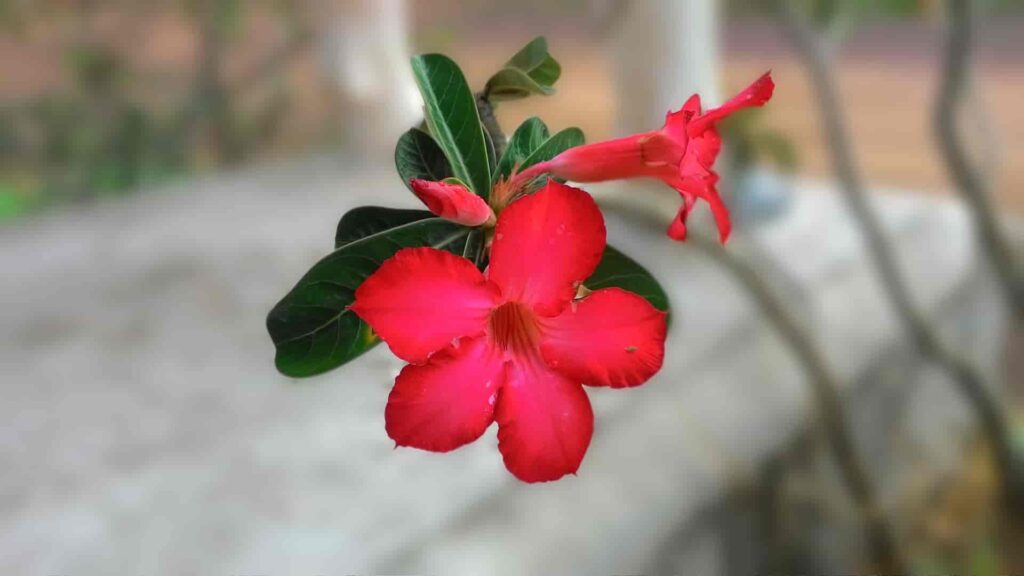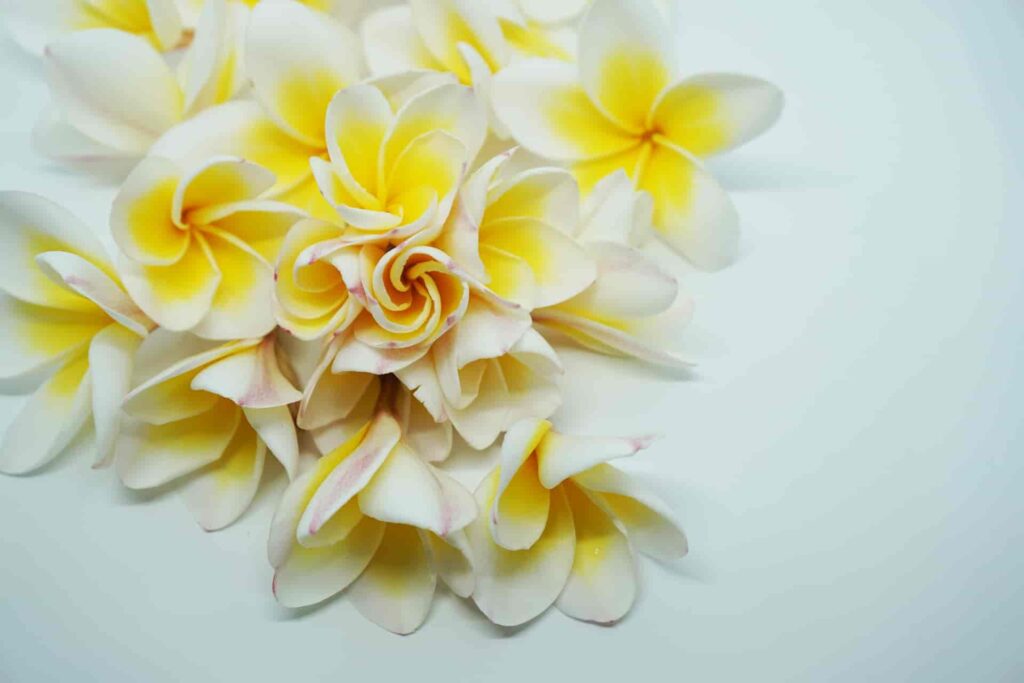Champa Plant or Frangipani, a beautiful flowering plant/shrub/small tree, is a warm-climate plant that comes in various colors. Champa plant is known by various names such as Frangipani, Plumeria Rubra, Hawaiian Lei Flowers, Barahmaasi Champa, Nag Champa Plant, Pagoda Tree, West Indian Jasmine, Temple Flower, Temple Tree, Nosegay, Green Paradise Plant, Champa White, Champa Red, Gulchin, etc.
The scientific name of the Champa Plant is Plumeria Spp. It belongs to the Apocynaceae family of plants.
Plumeria Alba or Champa plant is commonly grown as an ornamental plant across the world. It is known for the pleasant fragrance of its beautiful flowers.
It is normally grown for its fragrant flowers.
Champa plant is a very hardy plant that requires no to very low maintenance and care. Frangipani can survive in various climatic conditions. When fully mature, the Champa plant or Plumeria Alba forms a very thick and picturesque green canopy.
Champa plant is an outdoor ornamental plant. However, it can be grown indoors in pots.
Plumeria Alba’s natural habitat is subtropical regions of America and Asian countries. They are native to Mexico, Central America, and Polynesia.
Contents
How to Grow Champa Plant/ Frangipani?
Frangipani is an evergreen or deciduous tropical tree depending on the variety of plants you have. The branches are thick upright but are usually weak.
Types of Champa Plant / Frangipani/ Plumeria

Frangipani is famous for its attractive leaves and fragrant flowers. There are about 300 species in the genus of this plant.
Different plants bear flowers of different colors mostly a combination of red, pink, white, and yellow shades.
Most of its varieties are found in Southeast Asia.
The leaves are 12 to 21 inches long oval in shape. The texture of the leaves is leathery and they are dark green in color.
The bark of the plant is mostly green-grey.
As the plant ages, the branches on the trunk form an umbrella-like structure.
The sap of the plant is milky white in color.
Plumeria Obtusa is an evergreen shrub originating in Columbia.
Plumeria Rubra or Red Frangipani is native to Mexico, Central America, and Venezuela.
Height of Champa Plant
The height of the Champa Plant can vary up to 30 feet and can spread between 2 meters to 5 meters in width.
Some of the varieties of Plumeria Alba which are large are used as hedge plants.
Optimum Temperature to Grow Champa Plant
Frangipani or Champa Plant requires warm and humid conditions to grow and flourish.
When planting in containers and pots, save the plant from strong and cold winds.
They do well in USDA zones 10 to 12.
Sunlight Requirements
Plumeria Alba or Frangipani requires direct sunlight for optimum growth. Keep your plant in full sun for about 5-6 hours a day.
It can survive and grow in partial shade conditions as well.
Best Soil Type / Potting Mix
Frangipani likes a well-drained loam-based soil mix. Add sand to the soil mix to provide good drainage.
The soil needs to be rich in nutrients and minerals.
These plants do well in soil with a pH range between 6.1 to 7.5.
Flowering in Champa Plant

Champa plant normally flowers in the spring or summer season. The beautiful blooms have overlapping 5 petalled structures and are generally bicolored in various combinations. They have a tubular waxy texture.
The flowers have a very strong fragrance.
The flowers bear winged seeds.
Champa flowers are normally a combination of shades of white-yellow, white-pink and white with yellow throat.
Repotting & Pruning of Champa Plant
Plumeria can be grown in containers and pots.
When you buy a Champa Plant from a nursery, make sure you select a plant with multiple branches on it. Do not repot the plant immediately after the purchase. Let the plant acclimatize itself to its surroundings. Re-pot after 10 days from the date of purchase of the plant.
You should prune the tips of the branches to promote lateral and fuller growth of the plant. Pruning can be done once the flowering has stopped and flowers have fallen off the branches.
The best time to prune the plants is either late winter or early spring season. Be careful while pruning as too much pruning can also lead to a reduction in flowering.
Check this article on the must-have tools for your garden.
Propagation of Champa Plant
Champa Plant or Frangipani plant can be propagated by 2 methods:
Sowing Seeds
Sow the seeds of Plumeria Alba in the spring season in well-drained sandy soil.
Cuttings
Mature cuttings of leafless stem tips can be taken in spring and buried about 2 inches deep in the soil to propagate the plant. Ensure that the base of the cutting is dry before planting in soil. You can leave aside the cuttings for 3-4 days before planting them in the soil to prevent the development of any infection.
You can use a rooting hormone or cinnamon powder as the rooting medium to induce root growth.
It may take from a few weeks to few months for the cuttings to develop roots.
Mostly the propagation is done through stem cuttings.
Stem cuttings can be grafted to an already rooted plant system to produce new varieties of this plant.
Toxicity & Medicinal Uses of Champa Plant
The sap of the Champa Plant or Plumeria Alba can cause skin irritation in many people.
All parts of this plant are toxic. Hence animals do not eat this plant.
Plant Life Span
Champa Plant is a deciduous evergreen tree/plant/shrub – it provides shade in summers and allows Sun to spread warmth and light in winters.
Best Pot Material
Choose an earthen clay pot for good circulation of air and water through the pores of the earthen pot.
Fertilizing
You can use any organic fertilizer like cow-dung compost, vermicompost, bone meal, NPK, etc. to provide nutrition to Champa Plant.
When grown in pots, they should be provided fertilizers frequently to promote flowering in the plant.
They can be fertilized once every 15-20 days. Spring and summer seasons are the growing seasons for the Champa plant and hence they should be fertilized throughout the growing season.
A fertilizer rich in phosphorous (or phosphates) will promote and encourage blooms during the growing season. Apply this fertilizer before the summers to grow more flowers.
Too much nitrogen application will encourage more foliage growth and in turn, will reduce flowering in the plant.
Do not overfertilize the plant as it will hamper the flowering in the plant.
Winter Care of Champa Plant
Frangipani or Plumeria Alba is a deciduous plant and hence it sheds its leaves and flowers in the winter season.
They cannot tolerate extreme cold climates. Hence regions that witness frost and snowfall, the plants must be kept indoors during the cold spell.
Stop frequent watering in winters. Water only when the soil is dry
(Caution: Do not let the roots completely dry in which case the plant will die).
Watering / Irrigating Champa Plant
Plumeria Alba requires regular watering. The roots should not be left dry. They should be supplied with a lot of water. However, they are drought tolerant to some extent.
Based on the climatic conditions of the surroundings, the watering frequency of Frangipani changes. In hot climates, regular watering is necessary. In colder regions, you should check the moisture levels of the soil before giving a refill.
As with other plants, over-watering can lead to root rot. However, these plants are not very dramatic and can withstand little overwatering.
When the leaves start yellowing, it is a sign of overwatering.
Uses of Champa Plant
- The oil extracted from Frangipani is used as an astringent to treat headaches and improve functioning of nervous system.
- The extracted oil is used an antioxidant and find uses in cosmetic industry.
- It is used to cure Asthma, Diabeties etc. in different parts of the world.
- Roots bark of Plumeria Alba is used to treat herpes, syphilis etc.
- Stem latex is used to treat ulcers.
- Commonly used places of devotion and worship and symbolize dedication.
- Champa plant is considered auspicious as per Feng Shui.
- It attracts birds, butterflies and bees.
- It can tolerate salty conditions and hence is a good choice to grow on seaside areas and regions.
Diseases & Pest Control
Champa plant or Frangipani is very hardy and is normally resistant to most of the common plant diseases and pests.
Sometimes they can be attacked by spider mites, scales, mealybugs, thrips, nematodes, and whiteflies. They can be sprayed with a solution of 5-6 ml concentrated neem oil mixed with 2-3 drops of liquid sod mixed in 1 L of water. The plant should be thoroughly sprayed (above and below the leaves) once every 2 days till the pests disappear.
Neem oil spray can be generally applied once every week as preventive care to avoid pests and insects.
Hope you enjoyed reading this article. If you like it, please hit the share button below.
If you would like to read more interesting articles, please read the following posts:
2. Methi Plant/Fenugreek Plant: Uses and Benefits of Methi Seeds & Leaves
3. Plant Nutrition- What Are Fertilizers & How to Choose the Right One?






Leave a Reply